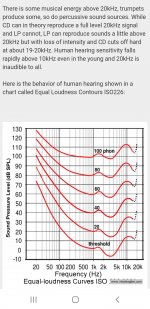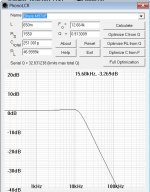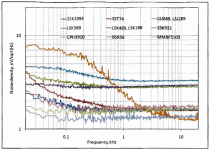I've answered that. The second and third harmonics of a piccolo, for a start. Otherwise a piccolo sounds like a sine wave, and it isn't. And that's only one example. Fourth and faith harmonics of a flute. I could go on.The main question is what's there so important to be recorded over 15kHz?
Same goes at the other end. Everybody says 20KHz is the lower limit, but there are instruments that go to 16 and even 8Hz.
Would you bet your life that you hear piccolo's 18 khz H2 clearly? Not asking about H3...
Last edited:
Sorry about my emotional outburst from yesterday
No problem. You can't take vinyl seriously these days. This is outdated technology, which today is just a toy for aging children. When we die, all of our turntables will immediately end up in the trash.
But you also have no evidence that there is useful information on vinyl above 20 kHz. The fact that we see components above 20 kHz in the spectrum is not proof. Vinyl has a high level of distortion, especially at high frequencies. Some of these distortions are associated with the playback process, some - with the recording process. For example, the Neumann SX-74 cutting head has a cutoff frequency of 25 kHz, but electromechanical feedback stops working above 14 kHz. The Neumann recording equalizer has an ultrasonic filter with a typical cutoff frequency of 33 kHz. But stories about vinyl recordings say that a 15 to 20 kHz low-pass filter was often used to limit the ultrasonic content and prevent the cutting head from overheating. Of course, you can play the entire frequency band from vinyl, although we do not hear the high frequencies. But this is more likely to bring harm rather than benefit due to intermodulation distortion.1. You state that everything above 20 kHz is distortion.
Quadraphonic vinyl recordings were made at half speed.In the 1970s quadrophonic records were cut with a subchannelcarrier above 50KHz.
Is this possibly the cause for creating an artificial resonance at 7...10 khz in cartridges or just a wonderful coincidence? Most headphones have also a dip at 10khz that might be naturally compensated by carts nonlinearities.
Besides I thought quadrophonic recordings are encoded recordings not ones with extended frequency ...
https://www.vinylengine.com/turntab...sid=6a339e1b25d1ad4d5bc8855375c545fb&start=12
From the picture I get that we hear 20hz much much worse than 20khz...so when we make a hearing test we probably hear 20hz speaker's own harmonics more than 20hz fundamental....
Besides I thought quadrophonic recordings are encoded recordings not ones with extended frequency ...
https://www.vinylengine.com/turntab...sid=6a339e1b25d1ad4d5bc8855375c545fb&start=12
From the picture I get that we hear 20hz much much worse than 20khz...so when we make a hearing test we probably hear 20hz speaker's own harmonics more than 20hz fundamental....
Attachments
Last edited:
What I never understand in these discussions is about why it is the engineers that get to decide about what is significant in the music, and not the musicians. I am speaking here as a member of both communities. Arthur Radford took measuring equipment to a Bournemouth Sinfonietta rehearsal to determine his LF limit. He could always have just asked somebody ... and got a different answer.
I get that in the digital world there is an incremental space cost of bandwidth, but almost any analogue circuit can be made to respond up to 50Khz without difficulty. So why wouldn't you do that? And avoid the aesthetic decision altogether?
NB Quadrophoic records are played at 33-13/rpm.
I get that in the digital world there is an incremental space cost of bandwidth, but almost any analogue circuit can be made to respond up to 50Khz without difficulty. So why wouldn't you do that? And avoid the aesthetic decision altogether?
NB Quadrophoic records are played at 33-13/rpm.
Yes, they play at 33 speed but are recorded at half speed. Because the cutting head is unable to record the required frequency band. On quadraphonic records, the L and R channels are recorded in the usual way, their spectrum is limited to 15 kHz. The band 20 - 45 kHz is occupied by a difference signal in the form of a modulated carrier.NB Quadrophoic records are played at 33-13/rpm.
Irrelevant. As a matter of fact I can hear to at least 17KHz, but it's not about what I personally can hear, it is about what is the content of the data. I know a builder whose hearing rolls off at 7KHZ, but he doesn't take that as a reason to just build amplifiers for customers to the same specification. Or as a reason to administer a hearing test before building.Can you hear 18khz or not?
Rule 1 of scientific data capture is to preserve as much of it as possible.
Herbert von Karajan is said to have instructed DGG that a CD had to be able to hold the Beethoven 9th symphony, 75 minutes. And they complied. That's a domain expert setting the constraints. Why aren't we doing that all the time?
And I fail to see what cutting speed has to do with it, if replay speed exceeds it. The greater of the two establishes an upper limit on what can be reproduced, and it is clearly above 50Khz.
Yes, some cartridges with a specially shaped stylus can play up to 50 kHz. For that matter, there were even video discs with mechanical recording, where the signal bandwidth reached 3 MHz. But what happens if everyone starts recording music up to 50 kHz? Do you think a miracle will happen? No one will even notice it.The greater of the two establishes an upper limit on what can be reproduced, and it is clearly above 50Khz.
It does matter for the ordinary listener if most professional musicians and electronics engineers as yourself don't hear a damn thing of what they preach.Irrelevant. As a matter of fact I can hear to at least 17KHz, but it's not about what I personally can hear, it is about what is the content of the data. I know a builder whose hearing rolls off at 7KHZ, but he doesn't take that as a reason to just build amplifiers for customers to the same specification. Or as a reason to administer a hearing test before building.
Rule 1 of scientific data capture is to preserve as much of it as possible.
It matters a lot if you preach a religion to us about a God you never saw, heard or felt in any way.
As a matter of fact 80's philips and sony engineers and hired musicians argue that limiting the audio bandwidth to 20 khz is ok so I'm curious what would have said the quadro-phony LP engineers about that!
In fact, if bats hear between 9khz and 120khz it means there's still sound outhere which might be relevant to future cyborgs with enhanced hearing aids...
As someone said once, the base of evolution was ignorance, the fact that we can filter irrelevant information.If our eyes would be seeing the whole light spectrum we'd be unable to see anything because we'd be saturated by huge amounts of radiations.
Try listening to this tweeter...maybe you hear what bats can't:
I'll be sort of off topic here for @ejp but he's a good engineer and I hope he'll be interested in making a clear scientific abx test with these two chips.
Here's a video with the old tda2050, who's thd was specified at 10khz in its datasheet, against the 20 years younger lm1875 and not only that tda2050 was 3 times better in both thd and imd tests , but lm1875 datasheet was simply telling lies about their product.
That's what a competent engineer at National Semiconductor or Texas instruments should do: telling lies about a 2 decades newer product.
You can check the rest of their datasheet and see for yourself how relevant the 20 khz measurements are.
Now what was really expected was that the higher thd amp was more stable and indeed , lm1875 was a bit more stable, but they didn't care about showing off with stability, instead they lied about distortions in the whole 20hz...20khz range cause that seemed to be the main market pressure and concern in the early 2000's .
By the way the idle current of lm1875 is double than tda2050 while tda2050 has 7% better efficiency and thus power than lm1875.That should tell a lot to an engineer! Of cource integrated circuits can give a better thermal coupling and provide for a better class B amp but who'd be able to appreciate that the class B amp was actually lower distortion although a bit more unstable?Of course, a smarter ST engineer from the 80's! They used to filter the inputs, to zobel the outputs and get that damn sound out! I've seen and heard the best implementations of tda2040 and 2050 in B&O and Telefunken TV sets made in the 80's and early 90's and they were nothing like the datasheet, because good engineers know how to squize a good product of everything it's got.
Some tradeoffs can't really be taken lightly!
Here's a video with the old tda2050, who's thd was specified at 10khz in its datasheet, against the 20 years younger lm1875 and not only that tda2050 was 3 times better in both thd and imd tests , but lm1875 datasheet was simply telling lies about their product.
That's what a competent engineer at National Semiconductor or Texas instruments should do: telling lies about a 2 decades newer product.
You can check the rest of their datasheet and see for yourself how relevant the 20 khz measurements are.
Now what was really expected was that the higher thd amp was more stable and indeed , lm1875 was a bit more stable, but they didn't care about showing off with stability, instead they lied about distortions in the whole 20hz...20khz range cause that seemed to be the main market pressure and concern in the early 2000's .
By the way the idle current of lm1875 is double than tda2050 while tda2050 has 7% better efficiency and thus power than lm1875.That should tell a lot to an engineer! Of cource integrated circuits can give a better thermal coupling and provide for a better class B amp but who'd be able to appreciate that the class B amp was actually lower distortion although a bit more unstable?Of course, a smarter ST engineer from the 80's! They used to filter the inputs, to zobel the outputs and get that damn sound out! I've seen and heard the best implementations of tda2040 and 2050 in B&O and Telefunken TV sets made in the 80's and early 90's and they were nothing like the datasheet, because good engineers know how to squize a good product of everything it's got.
Some tradeoffs can't really be taken lightly!
Attachments
even with not 450 pF but with "optimized" 250 pF Shure M97 is LPFed @ 12...15 kHz, see attached screenshot" If it ain't broke, don't fix it!"
https://www.lencoheaven.net/forum/index.php?topic=2253.105
http://www.hifi-classic.net/review/shure-m97he-307.html
Attachments
There is also a good JFET with an even lower capacity from Onsemi - CPH3910. There is not much data on noise in the datasheet, but in Audioexpress 12/2018 there was a noise comparison of transistors (at a drain current of 1 mA), where this transistor showed the best results. Horowitz and Hill also spoke well of this transistor as being low noise. There is also a dual version - CPH6904. And most importantly, these transistors are much cheaper than LSK or JFE.25 pF (LSK389) or 12 pF (jfe2140) }
Attachments
Pity that the sources of the dual version are tied together and that there is no offset spec:
| Is there any specification on the matching of the two transistors in the CPH6904? |
| We do not monitor matching between two transistors. There is a possibility that there will be a difference within specifications of the two transistors. |
Yes, it's a pity that the match is not monitored. But the price (MOUSER) of 0.72 euros for the CPH6904 vs 4.77 euros for the JFE2140 makes you forgive a lot. It can be expected that two crystals placed in a common case will be from the same lot. The main drawback is the increased zero shift, but the servo can handle it.
I can't hear 18kHz, but I can clearly hear the presence of a first order low pass filter with ft = 18kHz.Can you hear 18khz or not?
Well...that's just 6db/octave 🙂 Try Linkwitz 24db/octave....I can't hear 18kHz, but I can clearly hear the presence of a first order low pass filter with ft = 18kHz.
And how do you rate the difference? The other thread says this:I can clearly hear the presence of a first order low pass filter with ft = 18kHz.
If you do DBLTs with and without a sharp cut filter above eg 17kHz, you find that of those who can reliably tell the difference, the preference is ALWAYS for the bandlimited channel.
Sort of...after 12k...if those measurements are true...can't see clearly the images on the db scale :I would probably hear it, Linkwitz or not. Anyway, is an MM cart's response a Linkwitz one?
https://www.lencoheaven.net/forum/index.php?topic=2253.105
- Home
- Vendor's Bazaar
- Nick Sukhov SU-XXI MM Phono stage -85 dBA SN ratio...




